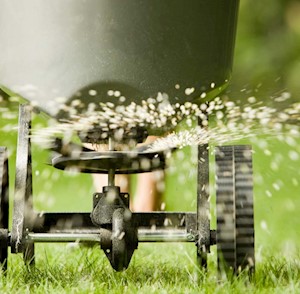 Lime is best spread on the lawn in pelleted form by a hand or rotary spreader.
Lime is best spread on the lawn in pelleted form by a hand or rotary spreader.
BanksPhotos / iStock / Getty Images
Adding lime to the lawn is a job that many lawn-owners believe is a regular, ongoing part of lawn care. Surprise - it’s not. Lime should be added to a lawn only when – or if – it’s needed. Many lawns never need lime at all, and in most other cases, an occasional application is all that’s needed. Unlike fertilizer, lime isn’t an amendment that a lawn uses and then constantly needs to be replenished.
Lawn grasses typically grow best in neutral to slightly acidic conditions – in the 6.2 to 7 pH range. Having ideal pH aids soil microbes that break down fertilizers and thatch and discourages the many weeds that thrive in acidic soil.
Keeping your soil in that range is important because it ensures soil nutrients are decomposing and being used efficiently. Overly acidic soils can lead to deficiencies in calcium, magnesium, and phosphorus and to excesses in aluminum and manganese - all of which can stunt grass growth.
Lime that’s bagged and sold as a lawn-care product is a crushed form of limestone rock. This mineral is one of the best (and cheapest) ways to make the soil more alkaline – or in other words, raise its pH.
How to tell if your lawn needs lime
pH is a measure of how acidic or alkaline a soil is, with a reading of 7 being neutral. Readings higher than 7 mean the soil leans alkaline, while readings lower than 7 mean it leans acidic.
The most accurate way to tell if your lawn needs lime is to test it. DIY kits are available at county Extension offices and through commercial soil-testing labs. Extension test kits also are sold at many garden centers.
These inexpensive tests not only give exact pH readings, they tell you if your lawn will benefit from a lime treatment, and if so, how much to apply. Never apply lime unless you’ve verified you need it. Otherwise, you’ll waste time and money and possibly do more harm than good by creating overly alkaline soil.
How to apply lime
For an even application, apply half of your total amount of lime in one direction, then apply the balance going the opposite direction. Water the lawn afterward to help drive the pellets into the soil and start the breakdown.
Lawns should not get more than 100 pounds of limestone per 1,000 square feet in any single application. If more is needed, apply half in spring or fall and the rest the following spring or fall. If you’re also fertilizing, it’s best to apply lime at least three weeks before applying fertilizer. And if a soil test shows your lawn is too alkaline, sulfur is a mineral that helps correct that.
If you need to lime…
Lime can be applied any time the ground isn’t frozen or when the lawn isn’t under heat or drought stress. Fall is most ideal (when rain and freeze/thaw cycles help work the lime into the soil), but spring also is a good time.
When shopping, look for pelletized or granulated lime, which can be spread with a hand-held or rotary spreader without the dust clouds that powdered or pulverized lime creates. (Those finer types of lime are intended for working into the soil before planting a lawn or garden.)